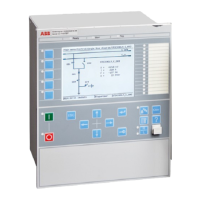13.3.3.3 Switch (SXCBR/SXSWI)
M16675-3 v7
tStartMove
is the supervision time for the apparatus to start moving after a command
execution. When the time has expired, the switch function is reset, and a cause-code is given.
During the
tIntermediate
time the position indication is allowed to be in an intermediate (00)
state. When the time has expired, the switch function is reset, and a cause-code is given. The
indication of the mid-position at SCSWI is suppressed during this time period when the
position changes from open to close or vice-versa if the parameter
SuppressMidPos
is set to
On
in the SCSWI function.
If the parameter
AdaptivePulse
is set to
Adaptive
the command output pulse resets when a
new correct end position is reached. If the parameter is set to
Not adaptive
the command
output pulse remains active until the timer
tOpenPulsetClosePulse
has elapsed.
tOpenPulse
is the output pulse length for an open command. If
AdaptivePulse
is set to
Adaptive
, it is the maximum length of the output pulse for an open command. The default
length is set to 200 ms for a circuit breaker (SXCBR) and 500 ms for a disconnector (SXSWI).
tClosePulse
is the output pulse length for a close command. If
AdaptivePulse
is set to
Adaptive
, it is the maximum length of the output pulse for an open command. The default
length is set to 200 ms for a circuit breaker (SXCBR) and 500 ms for a disconnector (SXSWI).
13.3.3.4 Bay Reserve (QCRSV)
M16677-3 v3
The timer
tCancelRes
defines the supervision time for canceling the reservation, when this
cannot be done by requesting bay due to for example communication failure.
When the parameter
ParamRequestx
(
x
=1-8) is set to
Only own bay res.
individually for each
apparatus (x) in the bay, only the own bay is reserved, that is, the output for reservation
request of other bays (RES_BAYS) will not be activated at selection of apparatus x.
13.3.3.5 Reservation input (RESIN)
M16678-3 v3
With the
FutureUse
parameter set to
Bay future use
the function can handle bays not yet
installed in the SA system.
13.4 Interlocking
IP15572-1 v2
M13530-4 v3
The main purpose of switchgear interlocking is:
• To avoid the dangerous or damaging operation of switchgear
• To enforce restrictions on the operation of the substation for other reasons for example,
load configuration. Examples of the latter are to limit the number of parallel transformers
to a maximum of two or to ensure that energizing is always from one side, for example,
the high voltage side of a transformer.
This section only deals with the first point, and only with restrictions caused by switching
devices other than the one to be controlled. This means that switch interlock, because of
device alarms, is not included in this section.
Disconnectors and earthing switches have a limited switching capacity. Disconnectors may
therefore only operate:
Section 13 1MRK 511 358-UEN A
Control
266
Application manual

